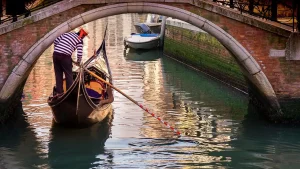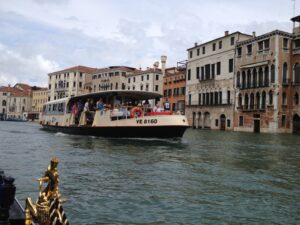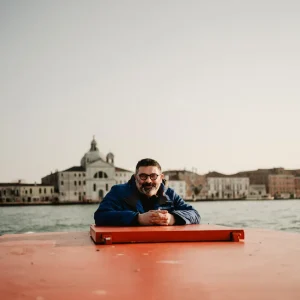San Michele — Venice’s Island of Silence and Eternal Rest
Every corner of Venice tells a story: the glittering mosaics of St. Mark’s Basilica, gondolas gliding beneath the Rialto Bridge, marble palaces mirrored in the Grand Canal. Yet to truly understand this city — its soul, its melancholy, its poetry — you must cross the water to an island where silence speaks louder than any song: San Michele, Venice’s cemetery island.
Floating between Venice and Murano, San Michele has been the city’s resting place for over two centuries. Behind its red-brick walls lie not only Venetians but also artists, poets, and visionaries from around the world — people who, like Venice itself, belonged to no single nation but to humanity at large. Here, the lagoon becomes a mirror of eternity, reflecting a beauty that transcends life and death.
Visiting San Michele is unlike anything else in Venice. There are no cafés, no crowds, no clinking glasses of Spritz — only stillness, cypress trees, and a feeling of reverence. It is a place where art, faith, and memory meet, inviting you to slow down and listen to the heartbeat of time itself.
📜 A Short History of San Michele
Before the Cemetery: A Monastic Island
San Michele has been inhabited for more than a millennium. In the 10th century, it was home to a Camaldolese monastery — a place of prayer and scholarship. The island’s church, San Michele in Isola, was rebuilt in 1469 by Mauro Codussi, who introduced Renaissance architecture to Venice. Its white Istrian-stone façade still gleams under the sun, elegant and austere, a quiet counterpoint to the Byzantine gold of St. Mark’s.
For centuries, Venetians were buried in churchyards scattered throughout the city — often within walking distance of where they lived. But Venice’s limited space and rising tides made burials increasingly difficult. The city, built on water, had nowhere left to bury its dead.
Napoleon’s Decree: The Birth of a Cemetery Island
In 1804, everything changed. Napoleon, who then ruled Venice, issued an imperial decree forbidding burials within populated areas for reasons of hygiene. The Venetian Republic had fallen, but its traditions endured — and now they faced a new reality. With no land to spare, Venice turned to the lagoon.
Authorities selected the islands of San Michele and San Cristoforo della Pace as the site of a new centralized cemetery. In 1837, the two islands were joined by filling in the narrow canal between them, creating the San Michele we know today — an island dedicated entirely to the dead, enclosed by brick walls and lined with cypress trees.
San Michele Today: The Island of Silence
Seen from the vaporetto, San Michele appears almost fortress-like — a rectangle of red walls floating in the lagoon, its bell tower rising behind. But once you step through the arched entrance, a different world unfolds: paths shaded by cypress, flowers on white marble tombs, sunlight flickering between leaves. The island’s stillness feels sacred, yet alive — as if time itself pauses to breathe.
The cemetery remains active to this day, tended by Venice’s caretakers and families. It is divided into sections — Catholic, Orthodox, Protestant — reflecting the city’s cosmopolitan heritage. Thousands of Venetians rest here, alongside the international artists and thinkers who once made Venice their muse.
🌿 Notable Burials — The Voices that Still Whisper
San Michele is more than a cemetery; it is a pantheon of creativity. Some of the greatest minds of the 20th century found their final peace here, drawn to Venice’s beauty and solitude.
🎵 Igor Stravinsky (1882–1971)
The Russian composer of The Firebird and The Rite of Spring lies beside his wife, Vera, in the Orthodox section. His grave is simple, almost modest — a contrast to the revolutionary complexity of his music. Musicians often leave small offerings: handwritten notes, flowers, or even a folded score. Nearby rests his friend and collaborator, the legendary ballet impresario Sergei Diaghilev.
💃 Sergei Diaghilev (1872–1929)
The visionary founder of the Ballets Russes transformed modern dance, introducing the world to Nijinsky, Picasso, and Stravinsky himself. Dancers from around the world make pilgrimages to his grave, leaving ballet slippers in tribute. The pale marble stone, surrounded by offerings, feels alive with creative energy even in silence.
📚 Ezra Pound (1885–1972)
The American poet — brilliant, controversial, and complex — spent much of his life in Italy. His grave, marked only by a simple stone bearing his name and the words “Who will ever tell the whole story?”, rests beside his lifelong companion, violinist Olga Rudge. Visitors often leave small books of poetry or stones inscribed with verses.
✒️ Joseph Brodsky (1940–1996)
The Russian-American Nobel laureate, exiled from the Soviet Union and adopted by Venice, rests here too. Brodsky loved the city’s winter light, calling it “the greatest masterpiece ever created by man.” His grave, shaded by cypress, has become a literary pilgrimage site for readers from every corner of the world.
🔭 Christian Doppler (1803–1853)
The Austrian physicist whose discovery of the Doppler Effect changed our understanding of sound and motion is buried here as well. His presence on this artistic island reminds visitors that San Michele embraces all human pursuits — art, science, and faith alike.
👪 Venetian Families
Beyond the famous names are thousands of ordinary Venetians — gondoliers, glassmakers, merchants, mothers, and children — who built and sustained the city. Their white tombstones stretch out like waves of memory, each one a story untold but deeply felt.
🏛️ The Church of San Michele in Isola
Dominating the island is San Michele in Isola, the first true Renaissance church in Venice and one of Mauro Codussi’s masterpieces. Its harmonious façade of white stone, clean lines, and classical balance marked a turning point in Venetian architecture. Before Codussi, Venice’s sacred spaces shimmered with Byzantine mosaics and Gothic tracery; here, the Renaissance arrived quietly, like a breath of reason after centuries of mysticism.
Inside, the church is a haven of proportion and light. Marble floors echo softly beneath your steps; faint incense lingers in the air. Attached to it is the Chapel of San Cristoforo, once part of the neighboring island. Together, they form an architectural dialogue between life and death — the spiritual and the eternal.
🕯️ The Experience of Visiting San Michele
Silence and Reflection
Unlike the lively chaos of Venice’s piazzas, San Michele speaks in whispers. The only sounds are the wind through cypress trees, the gentle lap of water against the walls, and the slow footsteps of visitors walking gravel paths. Even the occasional church bell sounds softer here, its echo fading into the mist.
A Cosmopolitan Island
Walking among the graves, you realize that San Michele reflects Venice itself — diverse, layered, and international. Orthodox crosses stand beside Latin inscriptions; Italian names share space with Russian, Greek, German, and English. This is a city — and a cemetery — that has always belonged to the world.
A Different Kind of Beauty
There is beauty in the quiet here — in the simple flowers, the chipped marble angels, the way light falls on ancient names. You will not find gondoliers or tour groups, only reflection. To wander San Michele is to confront the fragility of existence and the endurance of art, faith, and love.
🚤 How to Visit San Michele
By Vaporetto
The island is easily reached on vaporetto lines 4.1 or 4.2 from Fondamenta Nove — just five minutes across the water — or from Murano. As you sail, look for the red walls rising from the lagoon, a vision both solemn and serene.
Opening Hours
The cemetery typically opens at 7:30 AM and closes around 4:30 PM in winter or 6:00 PM in summer, with a midday pause. Hours can vary, so checking locally before your visit is advised.
Etiquette
- Dress modestly; this is an active cemetery.
- Keep voices low and movements respectful.
- Photography should be discreet; avoid photographing mourners or ceremonies.
- Refrain from picnics or phone calls — silence is part of the experience.
Private Visit with Tour Leader Venice
While you can reach San Michele independently, exploring with Tour Leader Venice transforms the experience. Our local guides illuminate not only the island’s history but also the stories of those who rest here — from Stravinsky’s music to Brodsky’s poetry, from Venetian artisans to forgotten saints.
Your visit can include:
- 🚤 Private boat transfer from your hotel, apartment, or pier in Venice.
- 👩💼 Licensed guide specialized in Venetian history and culture.
- 📖 Storytelling stops at notable graves and architectural highlights.
- 🕊️ Personal reflection time to absorb the island’s serenity.
- ✨ Optional continuation to nearby Murano, Burano, or Torcello for a full-day lagoon itinerary.
🌍 Why San Michele Matters
San Michele is more than a cemetery — it is a map of Venice’s soul. In its silence, you hear the echoes of a city that has always balanced life and death, grandeur and humility, water and stone. Here, art and faith coexist effortlessly: a poet’s grave beside a fisherman’s, a composer’s melody drifting toward eternity.
In a world obsessed with speed, San Michele teaches stillness. In a city defined by spectacle, it offers sincerity. And in an era of constant noise, it gives us the rarest gift of all — silence that heals.
To walk its paths is to realize that Venice is not a museum frozen in time but a living continuum of memory. The lagoon does not separate the living from the dead; it connects them, carrying whispers across the water. Every tide brings remembrance; every reflection, renewal.
💡 Insider Tips for Visitors
- Best Time to Visit: Early morning or late afternoon for soft light and solitude.
- Combine With: A visit to Murano for glass art, or a sunset bragozzo cruise for contrast and reflection.
- Read Before You Go: Brodsky’s essays on Venice or Jan Morris’s Venice to deepen your understanding of the city’s atmosphere.
- Bring: Flowers or a small token of remembrance — a Venetian tradition of quiet homage.
🌅 Final Thoughts — The Island of Silence
Venice dazzles the eyes, but San Michele speaks to the heart. Its stillness holds the weight of centuries, its air filled with the invisible music of memory. Here, surrounded by water and cypress, the great and the humble rest together, united by the same lagoon that shaped their lives.
As you leave the island and the vaporetto carries you back toward the shimmering domes of the city, look behind you once more. The red walls of San Michele will fade into the mist, but the peace you found there will remain — a quiet reminder that even in a city built on water, nothing truly disappears. Everything lingers, like a reflection on the tide.







